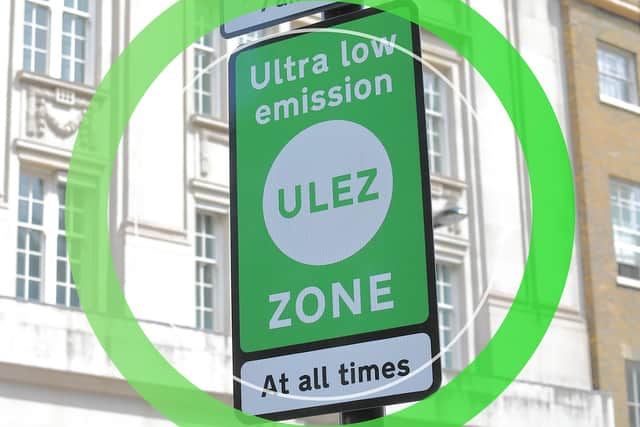ULEZ in jeopardy: do ultra-low emission and clean air zones make a difference for the environment?
and live on Freeview channel 276
Research by local authorities which have taken cleaner air in their civic centres into their own hands have shown that the policies are paying off, for both locals' health and the planet.
The public eye has turned back to the oftentimes controversial ULEZ - or ultra low emission zone - initiatives and expansions across the UK. Renewed interest comes after Labour narrowly lost to the Conservatives in a by-election for Boris Johnson's former seat of Uxbridge on Thursday night (20 July).
Advertisement
Hide AdAdvertisement
Hide AdVictorious Tory MP Steve Tuckwell attributed his success to London Mayor Sadiq Khan's "damaging and costly" ULEZ expansion plans. ULEZ and Clean Air Zone (CAZ) policies frequently see fierce opposition, especially when extended outside of urban hubs like London - which are well-served by public transport.
But the policies themselves are designed to improve air quality, and reduce the health and environmental impacts associated with vehicle emissions.
Are ULEZ and CAZ policies achieving what they are supposed to? Here's everything you need to know:
ULEZ in London
London has had a raft of relevant schemes over the years, but its ULEZ policy first came into force in April, 2019. It was expanded to cover all of Inner London in October 2021, and is currently set to be expanded once again on 29 August this year - to cover all of Greater London.
Advertisement
Hide AdAdvertisement
Hide AdSince it was first introduced, the London Mayor's website said peer-reviewed figures showed the initiative has contributed to a nitrogen dioxide pollution reduction of nearly 50% in Central London, and 21% in inner London - everything within the North and South Circular Roads.


According to the UK government's own guidance, nitrogen dioxide in outdoor air is associated with adverse effects on health, "including reduced life expectancy". The World Health Organisation says an increasing body of evidence links the gas - created when burning fossil fuels including those used in cars - with an increase in respiratory symptoms, asthma cases, lung cancer cases, decreased lung function, adverse birth outcomes, and deaths.
In London, vehicle pollution has fallen at five times the rate it has in the rest of the UK between 2016 (the year after future ULEZ initiatives were first announced) and 2020, the mayor's website said.
London's environment chief Shirley Rodrigues described ULEZ as “one of the most successful environmental initiatives in the world” in her address at a London Climate Action Week event, LondonWorld reported.
Advertisement
Hide AdAdvertisement
Hide AdShe described it - and its expansion - as key to tackling the wider climate emergency, where an urgent reduction in greenhouse gas emissions is needed to limit global average temperature increases, and their potentially disastrous impacts on the likes of biodiversity and weather systems.
"The ULEZ... has already led to a reduction of around 800,000 tonnes of [carbon dioxide], the equivalent of over two-and-a-half billion kilometres driven by a bunch of cars," she said.
The ULEZ and scrappage schemes - designed to help people replace non-compliant vehicles - are having a significant impact on reducing the number of "older, more polluting vehicles seen driving in London", the Mayor's website added.
Clean Air Zones in other major centres
Many other centres around the UK have followed suit in introducing low emission or CAZ policies - especially in the wake of government setting legal limits on air pollution.
Advertisement
Hide AdAdvertisement
Hide AdSome of those which have also been running for some time now have shown similar environmental success. In March last year, Birmingham City Council said overall levels of nitrogen dioxide had dropped 13% in the first six months of its CAZ scheme.
The council said it had also seen a significant drop in the number of "most polluting" vehicles entering the city centre, with the amount of traffic in this category falling from 18.7% of total traffic on 1 June 2021, to just 9.2% in April 2022.
How quickly do low-emissions zones take effect, and what do the experts say?
A study by Imperial College London found that after London first implemented its ULEZ zone, nitrogen dioxide levels had fallen by a few percent within the first few weeks.
However, it warned ULEZs were not silver bullet when it comes to countering air pollution and its environmental impacts.
Advertisement
Hide AdAdvertisement
Hide AdDr Marc Stettler said: “Our research suggests that a ULEZ on its own is not an effective strategy to improve air quality – the case of London shows us that it works best when combined with a broader set of policies that reduce emissions across sectors like bus and taxi retrofitting, support for active and public transport, and other policies on polluting vehicles.”
The researchers behind the study said it also highlighted the importance of combining them with clean air measures encompassing other harmful pollutants - including limiting the use of wood burning stoves, and enacting regional policies that reduce agricultural emissions.
Comment Guidelines
National World encourages reader discussion on our stories. User feedback, insights and back-and-forth exchanges add a rich layer of context to reporting. Please review our Community Guidelines before commenting.
